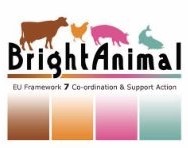ET4D (2023-2026)
ICT-AGRI-FOOD 2019 Joint Call: Development of a practical data management system with embedded sensors for improved environmental management and transparency of dairy farming

Our project brings together companies, academic research institutions and universities to foster information flow in dairy farms, consumers and other interest groups in the milk value chain via a web application. We will: 1) expand and validate an existing semi-commercial data management system with embedded sensors for environmental monitoring in dairy cattle barns 2) evaluate options to incorporate data from external sensor systems 3) demonstrate our system in multiple countries representing various technological, climatological and socioeconomical boundary conditions 4) analyse and improve the connectivity performance on case study farms 5) develop a scoring methodology to extract relevant information from the data to be considered in data filtering and aggregation algorithms 6) test a modular web application to provide information tailored to the different interest groups. We will further evaluate how farmers may benefit from transferring environmental information directly from farms to different interest groups. https://et4d.atb-potsdam.de/de/project
aWISH (2022-2024)
HorizonEurope call
HORIZON-CL6-2021-FARM2FORK-01-05: Animal Welfare Indicators at the Slaughterhouse 2.0

The goal of this proposal is to develop and apply technology for automated monitoring of animal-based welfare indicators at the slaughterhouse in order to give feedback to all stages of production of fattening pigs and broiler chickens (farmer, catching team, transporter, slaughterhouse) via an integrated feedback mechanism, and a catalogue of relevant animal welfare indicators.
LivestockSense (2021-2023)
ICT-AGRI-FOOD 2019 Joint Call: Enhancing environmental sustainability of livestock farms by removing barriers for adopting ICT technologies

The application of advanced information and communication technologies (ICT) allows for intense monitoring of various livestock species and their surroundings, improving the economic and environmental viability of livestock farms.
The air quality and thermal environment in livestock buildings have an impact on the biological and economic efficiency of livestock production and the environmental viability of farms.
If social barriers for technology adoption are identified and eliminated, a greater level of technology adoption can be achieved on farms.
D4Dairy (2018-2022)

(Digitalisation, Data integration, Detection and Decision support in Dairying)
Digitalisation in agriculture is a rapidly growing field. But digitalisation also means an enormous accumulation of data. In order to be able to use this information for the benefit of farmers, veterinarians, consultants, processors and other partners along the milk value chain, D4Dairy’s main objective is to link data and know-how from company and scientific partners. Using state-of-the-art data analysis methods (BigData, Mid-Infra-Red Spectra, etc.), new insights into the practical benefits for farmers and partners along the dairy value chain will be explored.
Entrepreneurs’ Programme, Accelerating Commercialisation (2017-2019)

Pig producers have limited opportunities and technologies available for the continuous monitoring of their animals. The combination of the building environment, feed intake and average daily weight gain monitoring provide a real-time decision-making system for livestock producers for increased production efficiency, better risk management, detection of sub-optimal health and welfare indicators. The system will be applicable to intensive beef and poultry production therefore it will be suitable for multi-species intensive livestock farm managers.
EU PLF (2012-2016)

The main objective of EU-PLF was to make PLF installations operational in commercial farms for 3 different species: broilers, fattening pigs and dairy. The project aimed to make participating farmers familiar with the installations and analyse how they experience this new technology. The results were then evaluated from the automated PLF system. Human experts assessed the animals during each production period using the Welfare Quality protocols as a reference. All these efforts were brought together to realise the main objective, which was to deliver a PLF-Blueprint for farmers on how to install and use this technology.
Smart Pigs (2012-2014)

ALL-SMART-PIGS aimed at demonstrating the viability of smart farming technologies in European pig farming. The project used a process of open innovation through a LivingLab (LL) to co-create smart farming applications ready for commercialisation on European pig farms. These applications provided by innovative SMEs and have been tested and validated in ALL-SMART-PIGS with their technological prototypes and services in real life conditions together with pig farmers and other stakeholders. The project initiators had identified health, growth rate, feed usage and environmental conditions as key parameterrs to monitor in this project.
Bright Animals (2009-2011)

The European Union funded Coordination and Support Action ‘BRIGHTANIMAL’ set to assess what has been achieved so far in PLF (Precision Livestock farming) and to highlight needs for future research in the area. The goal of BRIGHTANIMAL was to identify practical and acceptable PLF. This has been performed with a multi-disciplinary, team of experts from all five continents. In particular, the project team included experts on business and on ethics, as well as biologists and engineers.
